ESP
SOMATOTIPO
¿Qué es y por qué es relevante en el deporte?
El somatotipo es la morfología, el perfil antropométrico o la arquitectura corporal de las personas. Permite conocer la tipología del atleta y compararla con atletas del mismo u otros deportes, así como detectar talentos y guiar deportistas hacia disciplinas adecuadas para su morfología.
El somatotipo tiene tres componentes; endomorfia, mesomorfia y ectomorfia, que describimos a continuación:
Endomorfia se refiere a las formas redondeadas, son sujetos con un gran porcentaje de grasa corporal que tienden a ser obesos.
En la mesomorfia predomina la masa muscular y son sujetos con una osamenta compacta.
Por último, en la ectomorfia hay un predominio de las medidas longitudinales, son sujetos altos y delgados.
Figura 1. Somatocarta o triángulo de Franz Reuleaux
En cada persona existen los tres componentes, pero uno suele predominar sobre el resto. Antiguamente, se creía que el somatotipo fue determinado exclusivamente por factores genéticos, pero hoy en día es conocido que puede ser modificado con la alimentación y el entrenamiento.
Por medio de medidas antropométricos (pliegues cutáneos, diámetros y perímetros), se calcula cada uno de los componentes y el resultado nos da el somatotipo del deportista. Uno de los más utilizados es el de Carter y Heath (1990).
En los somatotipos balanceados, hay un componente que destaca sobre los otros dos, los cuales son iguales (o no se diferencian en más de 0,5). Serían los perfiles representados por las letras A, B y C en la Figura 1. Otra posibilidad es que haya dos componentes iguales y otro menor. Serían los perfiles D, E y F. El resto de los perfiles (G, H, I, J, K, L) se nombran a partir de los componentes entre los que se encuentran, citando primero el sufijo del componente más alejado. Por ejemplo, el J sería meso-ectomorfo.
Una vez calculado el somatotipo del deportista, es posible representarlo gráficamente en una somatocarta. Si conocemos el somatotipo de la población de referencia, lo podemos representar también en la somatocarta y así comparar nuestro deportista con los de la población de interés.
Recientemente, la investigadora Alicia Canda publicó el libro “Variables antropométricas de la población deportista española”, en la que presenta datos de referencia para múltiples deportes recogidos a partir de una muestra de más de 2.000 deportistas españoles de nivel nacional y/o internacional. En la siguiente figura, se representa el somatotipo de algunos de los deportistas estudiados por Canda.
Figura 2. Perfil de corredores de distintas modalidades y triatletas. Fuente: elaboración propia a partir de datos de Canda (2012).
Como podemos observar, la mayoría de los deportistas tiene el somatotipo I (ecto-mesomorfo) o J (meso-ectomorfo). Los triatletas tienden a tener un mayor componente mesomorfo (I), mientras que los corredores tienen un mayor componente ectomorfo (J). Además del somatotipo, Canda provee otros datos interesantes, como pliegues cutáneos, áreas transversales de brazo, muslo y pantorrilla, así como estimaciones de la masa muscular que permite una comparación más pormenorizada de nuestros deportistas.
El somatotipo de triatletas (modalidad sprint) y ciclistas es parecido (mesomorfo). Según este estudio, ciclistas y triatletas presentan un peso similar, pero triatletas son de talla más baja. Por último, el porcentaje de masa muscular de ciclistas es mayor que triatletas y corredores.
Si te interesa saber tu somatotipo y ver tú comparación con atletas de élite en tu deporte, no dudes en ponerte en contacto con nosotros para realizar tu estudio antropométrico y de composición corporal. Posteriormente, podremos diseñar un plan de entrenamiento y unas pautas nutricionales para acercarte al somatotipo ideal para tu deporte.
Cati Beggan | SPORT LAB
ENG
SOMATOTYPE
What is it and why is it relevant in sport?
Somatotype refers to the morphology, anthropometric profile or corporal architecture.It allows us to determine the type of athlete and compare them to other athletes of the same or different disciplines, as well as spot talent and guide individuals to sports appropriate for their body type.
Somatotype is made up of three elements; endomorphy, mesomorphy and ectomorphy, which we explain below:
Endomorphy refers to rounded characteristics, they are individuals with a large percentage of body fat and tend to be obese.
In mesomorphy, muscle mass dominates and they are subjects with a compact skeleton.
Lastly, in ectomorphy, linear measurements dominate, they are tall, thin subjects.
All three elements are present in everyone, but one usually dominates over the others. In the past, it was believed that somatotype was determined exclusively by genetics, but nowadays it is recognized that it can by modified by diet and exercise.
Using anthropometric measurements (skin folds, diameters and perimeters), each of the elements are calculated and the result shows us the somatotype of our athlete. One of the most used formulas to determine somatotype is that of Carter & Health (1990).
In balanced somatotypes, one element stands out above the other two, which are equal (or do not differ more than 0,5). They would be the profiles corresponding to the letters A, B and C in Figure 1. Another possibility is that two elements are equal and the third is lower. Those would be profiles D, E and F. The rest of the somatotypes (G, H, I, J, K, L) are named based on the elements between which they are located, citing first the element furthest away. For example, J would be meso-ectomorph.
Once we have calculated the somatotype of our athlete, we can represent it graphically on the Franz-Reuleaux triangle. If we also know the somatotype of the reference group, we can represent this on the graph and compare our athlete to the reference group.
Recently, the investigator Alicia Canda published a book in which she presents reference data for a large number of sports gathered from a sample of more than 2,000 Spanish athletes of national and/or international level. In the following figure, the somatotype of some of the disciplines studied by Canda are presented.
As we can see, the majority of these sportspeople are somatotyoe I (ecto-mesomorph) or J (meso-ectomorph). Triathletes tend to have a larger mesomorphy element (I), while runners have a larger ectomorphy element (J). As well as the somatotype, Canda also provides other interesting data, such as skin folds, cross-sectional area of arm, thigh and calf, along with estimations of muscle mass which facilitates a more in-depth comparison of our athletes. In the following table, you will find some data on estimated muscle mass in this small sample of sportspeople.
The somatotype of sprint triathletes and cyclists is very similar (mesomorph). According to another study, cyclists and triathletes present similar weight, but triathletes are generally shorter and cyclists have a higher percentage of muscle mass than triathletes and runners.
If you are interested in knowing your somatotype and seeing how you compare to elite athletes in your discipline, don’t hesitate to contact us for your anthropometric and body composition study. Once we know your profile, we can design a training plan and nutritional guidelines to help bring you closer to the ideal somatotype for your sport.
References
Canda, A.S. (2012). Variables antropométricas de la población deportista española. Madrid: Consejo Superior de Deportes. Recuperado de http://munideporte.org/imagenes/documentacion/ficheros/029C0791.pdf
Rivas, L. G., Mielgo-Ayuso, J., Norte-Navarro, A., Cejuela, R., Cabañas, M. D., & Martínez-San, J. M. (2015). Composición corporal y somatotipo en triatletas universitarios. Nutrición Hospitalaria, 32(2), 799–807. doi: 10.3305/nh.2015.32.2.9142.
Cati Beggan | SPORT LAB





